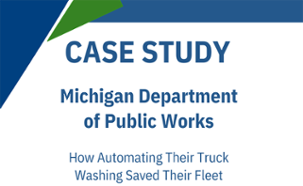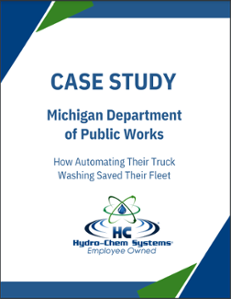The most neglected part of fleet washing is always the undercarriage. But it’s also one of the most important areas you should target. But how do you clean the undercarriage of your trucks, trailers, and other vehicles so they don’t rust?
In this article, we'll explain why it’s so important for your business to know how to clean your undercarriage properly, how to protect it against rust, and show you the five most common ways to do it effectively for an entire fleet.
Why it is Important to Clean the Undercarriage of Your Truck
The reason why most people ignore their undercarriage is because they can’t see it.
And that’s understandable, especially when you consider that it’s designed to withstand bumps and scratches, protect the mechanical components, and complete the frame of your trucks.
But your undercarriage is also where many crucial components are such as your brake lines, axles, gearboxes, and more. It is also an area that’s constantly exposed to dirt, grime, and road salt.
That’s why washing the undercarriage of your truck is so important. It cleans those vital parts so they’re more easily visible and helps prevent rust and corrosion that build up over time.
That means you can lower maintenance costs and reduce the chance of mechanical failure, and extend the life of your vehicle
5 Ways to Clean Your Undercarriage And Help Prevent Rust
There are quite a few different ways to clean the undercarriages of your trucks. Some are more economical while others are more efficient.
You should choose the method that makes the most sense for your business.
Here are the five most common ways to do it and how effective they are.
1. Cleaning your undercarriage with a hose and brush
This is the most basic way to clean your undercarriage and it’s also the most time-consuming.
One reason why it’s still such a common method of cleaning is because a lot of people are still concerned with using a pressure washer to clean their vehicles, fearing that it could damage their trucks. It’s also very simple.
So they start by jacking up their rigs, lightly hosing them down, and then brushing off a lot of the thick mud and debris.
Then they use a truck washing soap or degreaser to help them remove any remaining grease or grime.
It should go without saying, that if you maintain a whole fleet of semi-trucks and 18-wheelers, that this method isn’t a smart idea for your business. It would take days to clean every vehicle and isn’t as thorough.
2. Cleaning your undercarriage with a pressure washer and brush
This is easily the most common method for cleaning the undercarriage of trucks, trailers, and even most cars.
The biggest difference here is using a pressure washer to wash faster, remove bigger clumps of mud, and help get into the hard-to-reach areas.
The problem is you would still need to use a brush to remove much of the road film which can take days to do for an entire fleet. You would also still need a way to either slide under the trucks, raising them up, or by driving them all onto a platform one by one.
3. Cleaning your undercarriage with touchless detergents
The most efficient and effective way to clean the exterior of the entire vehicle is with the 2-step “touchless” method.
This involves spraying a low pH pre-soak with your pressure washer as the 1st step in the process to to clean the vehicle. This step works incredibly well on minerals, including road salt.
Once you allow that to dwell for a few seconds, you follow it up with the 2nd step by spraying a high pH soap directly onto the low pH. This step neutralizes the low pH and works on oils and grease.
Then you simply rinse it off, completing the process.
You could use a touchless 2-step method for regular undercarriage washing as well. However, based on the film you are cleaning, you may find using the detergents separately may be more effective for undercarriage cleaning.
By using a low pH detergent, you can effectively neutralize road salts and de-icing solutions while also breaking down surface rusting.
When using a high pH, alkaline detergent, you can more effectively remove heavy greases and oils making it easier to perform inspections or replace mechanical parts.
The biggest disadvantage here is similar to the first two options - it can be difficult to get into the hard-to-reach places on the undercarriage if the vehicle isn’t raised up or your wand isn’t at a good angle.
4. Cleaning your undercarriage with an undercarriage cleaner
Undercarriage cleaners are great because you can use them without having to drive your trucks onto a platform.
They can also be used alone purely to keep the undercarriage clean, or as part of a larger washing process to keep the entire vehicle clean.
The only real downside to using an undercarriage cleaner is having to switch back and forth with your regular method of washing. Depending on the equipment you use, you may have to attach and detach your pressure washer in order to fully clean the vehicle using both the undercarriage cleaner and your pressure washer. A quick connect part can help make it faster, but it is still an additional step.
There are smaller undercarriage pressure washing wand attachments for smaller vehicles as well as complete rolling wheeled assemblies for larger pieces of equipment.
So make sure you get the model that suits both your vehicle shape and the pressure washer you use. Not all pressure washers are powerful enough to use with many undercarriage cleaners.
5. Cleaning your undercarriage with an automated truck wash
An automated truck wash can clean your truck up to nine times faster than using a normal pressure washer. But they also come with an extra feature that lets you clean your undercarriage at the same time as the entire vehicle, making it incredibly fast and easy.
Instead of power washing and cleaning each truck individually, you can drive your entire fleet through the system one after the other, and get a better clean in those hard-to-reach places in a fraction of the time.
The challenge to using an automated wash is the upfront investment, installation time, and finding the right space to set up the system. Occasionally, fleets will choose to get an automated system that only washes the undercarriage in order to lower some costs, but many find the full system well worth the investment.
It is a better, faster clean that will eventually pay for itself. It also doesn’t require any additional manual labor, saving both time and money.
Frequently Asked Questions
How does cleaning your undercarriage help prevent rust?
While there is no foolproof way to prevent rust, there are many ways you can prevent it from doing a lot of damage or at least building up. Rust is caused when the paint around the undercarriage is scraped off and the bare iron is exposed to water and oxygen, otherwise known as oxidation. Over time that rust will weaken vital parts of your truck. This can be made worse by road salt. The best way to prevent this is by regularly cleaning your undercarriage in combination with a special coating.
Why is it important to clean road salt from your undercarriage?
Road salts are extremely corrosive. They will eat away at the exterior, undercarriages, and even metal framework of your trucks and buses. They also leave a thin coating on your undercarriage that is difficult to remove with just water. Neutralizing the road salts can become even harder after they combine with organic molecules from the road, including diesel, motor oil, and gasoline, as well as other inorganic compounds. That’s why it’s wise to neutralize the road salt on your undercarriage often in winter.
Should you use an undercarriage spray?
Another technique you could use to protect your undercarriage is applying a wax sealant or undercarriage spray. It can help create a protective layer over the frame to prevent some of the salt from accumulating in the first place. Just make sure you do it while it’s dry, preferably before winter when it snows or rains, and regularly throughout the winter.
How often should you clean your undercarriage?
How often you clean your undercarriage is completely dependent on how frequently it’s being used, the types of roads it drives on, and the climate. The dirtier the truck or the more exposed it is to grime and road salts, the more often it should be cleaned. Many fleets with access to an automated wash system will use it daily.
How to identify undercarriage damage?
The easiest way to identify undercarriage damage is by listening for it during a drive. It could be rusted parts, corroded brakes, or loose/broken parts. The other thing you can do is check under your truck to see if there are any leaks, cracks, or holes. If left alone, these things can all get worse. Finally, if you notice a strong smell, whether that’s because of oils or chemicals, that’s a good sign your undercarriage could be damaged.
The Bottom Line: How to Clean the Undercarriage of Your Truck
Cleaning the undercarriage of your truck might feel like overkill but it will pay off in the long run. That’s because it’s the area that protects so many vital components and cleaning it regularly can help prolong its life.
A thorough undercarriage helps prevent rust and corrosion, and helps you avoid spending thousands of dollars on maintenance and repairs.
Not every business needs the same undercarriage cleaning method. It depends on how many vehicles you have, their shape and size, and what area of the country they tend to drive around.
Hopefully, this article helps you make a more informed decision when cleaning your trucks and helps you operate your fleet more efficiently.


%20Blog.png?width=1080&height=675&name=How%20to%20Clean%20the%20Undercarriage%20of%20Your%20Truck%20(5%20Proven%20Techniques)%20Blog.png)

